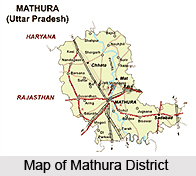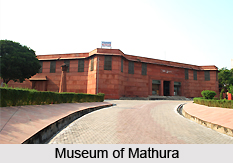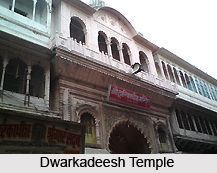 Mathura District in Uttar Pradesh is situated along the banks of the Yamuna River. The historic town of Mathura is the district headquarters.
Mathura District in Uttar Pradesh is situated along the banks of the Yamuna River. The historic town of Mathura is the district headquarters.
Location of Mathura District
Mathura District is a part of Agra division. Mathura District is bounded on the northeast by Aligarh District, on the southeast by Hathras District, on the south by Agra District, and on the west by Rajasthan and northwest by Haryana, another Indian state. Mathura district is an important pilgrimage centre of Hindu community.
History of Mathura District
Mathura District has an ancient history. According to the Archaeological Survey of India the city of Mathura is mentioned in the oldest Indian epics of Ramayana and Mahabharata. In the epic of Ramayana, the Ikshwaku prince Shatrughna slays a demon called Lavanasura and claims the land. Afterwards, the place came to be known as Madhuvan as it was thickly wooded, then Madhupura and later Mathura. In the 6th century BC Mathura became the capital of the Surasena Mahajanapadas, one of the 16 Mahajanapadas. The city was later ruled by the Maurya Empire from 4th to 2nd centuries BC. Later it came into the hands of Sunga dynasty in 2nd century BC.
 It may have come under the control of Indo-Greeks some time between 180 BC and 100 BC. It then reverted to local rule before being conquered by the Indo-Scythians during the 1st century BC. The art and Culture of Mathura District reached at its height during the time of Kushana Dynasty. The capital of Kushanas at that time was Purushapura. Megasthenes, a Greek ambassador during the time of Guptas mentioned Mathura in writings of early 3rd century BC. The city of Mathura in the medieval times, which is now called Mathura District was plundered by Sultan Mahmud of Ghazni in 1018 and again by sacked by Sikandar Lodhi, who ruled the Sultanate of Delhi from 1489 to 1517.
It may have come under the control of Indo-Greeks some time between 180 BC and 100 BC. It then reverted to local rule before being conquered by the Indo-Scythians during the 1st century BC. The art and Culture of Mathura District reached at its height during the time of Kushana Dynasty. The capital of Kushanas at that time was Purushapura. Megasthenes, a Greek ambassador during the time of Guptas mentioned Mathura in writings of early 3rd century BC. The city of Mathura in the medieval times, which is now called Mathura District was plundered by Sultan Mahmud of Ghazni in 1018 and again by sacked by Sikandar Lodhi, who ruled the Sultanate of Delhi from 1489 to 1517.
Geography of Mathura District
Mathura is located at 27.28 degree north to 77.41 degree east. It has an average elevation of 174 metres from sea level. The climate of Mathura is tropical extreme type with very hot summers with temperatures rising beyond 44 degree Celsius. The cold and foggy winters in Mathura District, with temperature dipping to 5 degree Celsius attracts the nature loving tourists also. The average rainfall is 593 mm, received mostly during the monsoons from July to September.
Population of Mathura District
The Population Census of 2011 stated that in Mathura district there was a population of 2,541,894. This gives Mathura District a ranking of 167th in India, out of a total of 640 districts in India. The district has a population density of 761 inhabitants per square kilometre. Its population growth rate over the decade 2001-2011 was 22.53 percent. Mathura has a sex ratio of 858 females for every 1000 males. The literacy rate of Mathura District is 72.65 percent.
 People of Mathura District
People of Mathura District
Mathura District with its headquarters at Mathura city is a Jat dominated region with around 3 lakh Jats. Mathura City receives a large number of daily visitors besides pilgrims who stay for an average of 3 days. The urban area of Mathura is dense and the urban population ranges between 100,000 to 125,000 per day, whereas on festive and auspicious days it is over twice the population of urban area. People in Mathura and nearby areas speak Braj dialect (Braj Bhasa).
Tourism in Mathura District
Mathura District abounds in place of religious and historic interest. All round the year, a large number of religious festival and fairs are held in Matura District and adjoining areas of Vrindavan Gokul, Brazen and Goverdhan Mountain. With the birth place of Lord Krishna, there are many tourist attraction sites like Jama Masjid, Dwarkadheesh Temple, Mathura Museum and Vishram Ghat.






